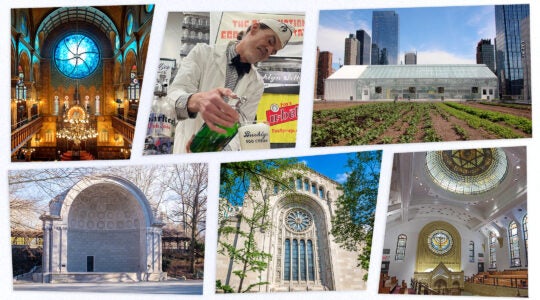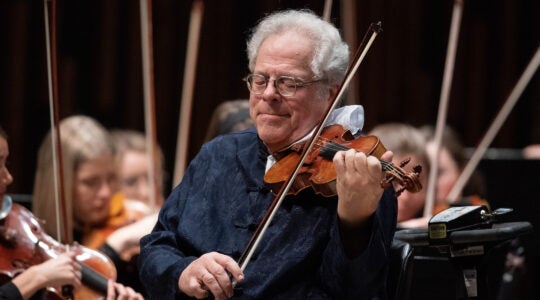At first glance, the Lower West Side of Buffalo is not the most photogenic neighborhood. Seen through the lens of optometrist-turned-photographer Milton Rogovin, however, one of the poorest urban areas in New York State reveals a wealth of individual stories full of dramatic difficulty and bittersweet joy.
His portraits of otherwise overlooked subjects (including growing families and longtime friends, steel mill workers, drug abusers, prostitutes and preachers) are currently on view in "The Forgotten Ones," an exhibition at the New-York Historical Society.
"The rich ones have their own photographers," Rogovin said in an interview with the radio producer David Isay. "I feel my goal is to zero in on those who I consider ‘the forgotten ones.’ "
Once labeled "Buffalo’s Top Red" for his union-organizing activities, the 93-year-old photographer found a kindred spirit in Isay, 37, a charismatic advocate for underdogs, who has established a reputation in his radio documentaries for seeking out "the poetry on the edges of society."
Isay helped Rogovin organize the exhibition and an accompanying book (The Quantuck Lane Press, 2003). His company, Sound Portraits Productions, created an audio narration for "The Forgotten Ones" that features the voices of Rogovin and several of his subjects, whom he photographed multiple times over the course of three decades.
"I think the stories of ordinary people are more interesting that the stories of celebrities," Isay told The Jewish Week over a glass of milky ice tea at a coffee shop near his Chinatown office. "Ordinary people who do extraordinary things."
A tall man with soft features and a quiet intensity, Isay said he wants to offer people a better alternative to "the kind of stories … they’re getting in news magazines, ‘The Bachelor,’ that kind of crap … I may be a total fool, but I think that if people are given better stuff they’ll respond to it," he said.
Isay’s award-winning forays to the country’s fringes have taken him to the planet’s only pawn shop/wedding chapel, a dog graveyard and a struggling Southern synagogue, among dozens of other unusual destinations. Darker corners famously include flophouses on the Bowery, housing projects in Chicago, the Louisiana State Penitentiary and Texas death row.
Last year, he toured the country with a live production of the "Yiddish Radio Project," a compilation of recordings from the 1930s to the 1950s salvaged by Isay and ethnomusicologist Henry Sapoznik. The radio version earned a 2003 Peabody Award for broadcasting: Isay’s fourth, among over a dozen prestigious awards including a MacArthur "genius" Fellowship.
Most recently, Isay won the National Foundation for Jewish Culture’s Media Arts Award. The medal is displayed somewhat unceremoniously in the headquarters of his 10-year-old non-profit company, hung around one of two Robert F. Kennedy Award trophies. (A post-it note playfully stuck to the to the medal reads, "Jew of the Year.")
The son of a book editor mother and a psychiatrist father who advocates for gay rights, Isay said that in the last few years he has become more interested in the "effect that the [documentary-making] process has on the person being documented than the person creating the documentaries."
His latest endeavor, StoryCorps, would put recording booths in public spaces across the country, thus enabling ordinary Americans to "collect one another’s stories in sound" and in the process creating an oral history of America. StoryCorps is also planned to have a Jewish component, which could "re-invigorate the bar/bat mitzvah ceremony" by making oral history part of the ritual.
"For Jews, so much is about memory and remembering and respecting older people," Isay, who became a bar mitzvah in New Haven in 1979, said. "And it really is a profound thing to sit there and really listen to someone tell their story."
Isay gave up medical school for radio in 1987, when he recorded his first story about two ex-junkies set on opening a museum to drug addiction. Since then, he’s created a hallmark style in which his subjects speak for themselves with minimal narration.
"You feel like in some ways gotten inside the soul of these individuals," Alex Kotlowitz, an award-winning radio producer and author, said of Isay’s stories. Kotlowitz’s 1991 Pulitzer Prize-winning book "There Are No Children Here" inspired Isay’s two acclaimed documentaries from Chicago’s Ida B. Wells housing projects, "Ghetto Life 101" and "Remorse: The 14 Stories of Eric Morse."
Both programs were reported by a pair of young Chicago residents, LeAlan Jones and Lloyd Newman. Their story inspired a recent TV film version on the Showtime cable channel, titled "Our America" after a book based on the radio program.
About the film, Isay would say only that the actor who played him, Josh Charles, "did a good job. He wore a lot of T-shirts and jeans and was very messy."
Dressed, for a change, in an orange short-sleeve button down, Isay was eager instead to talk about StoryCorps and its Jewish counterpart, called "Zakhor" (for the Hebrew command, "Remember").
Sound Portraits has already put out the call for facilitators to man StoryBooths and to guide would-be interviewers through effective techniques and questions. The 40-minute interviews will be recorded on CD, but only a handful will be edited for broadcast on National Public Radio. The most important piece of the project is how it affects the two people sitting in the booth, Isay said. "In some ways, it’s like therapy in a box."
The first such box is set to be installed at Grand Central Terminal in October. If funding can be found, another StoryBooth will be located in the sanctuary of the Eldridge Street Synagogue, a century-old shul on the Lower East Side.
More than therapy, Zakhor is being described as a way "to build the Jewish future by preserving its past." According to a draft press release, it will address the "crisis of meaning in the contemporary bar/bat mitzvah celebration by proposing a new ritual."
The goal is to have boys and girls interview older relatives and then incorporate material from the interview in the bar or bat mitzvah service. At age 18, the interviewer can update the interview and will qualify to become a trainer for a new crop of interviewers.
The press release cites historical precedents in Jewish oral history, from the Oral Torah and the Aggadah to the chasidic master Nahman of Bratslav and the 20th-century Russian ethnographer S. Ansky, whose work was taken up after his death by a team of amateur collectors, known in Yiddish as "zamlers."
"Every Jewish child who interviews an older relative for his or her bar/bat mitzvah will be transformed into a zamler," the release states.
Isay came across the Eldridge Street Synagogue while working nearby on "Flophouse: Life on the Bowery," a radio documentary, book and exhibition he created in 1998 with producer Stacy Abramson and photographer Harvey Wang.
"The first time I went there, there was a class of 50 Chinese kids in the basement screaming out Chanukah songs, and I knew I had found my spiritual home," Isay said.
Sound Portraits has already engaged a project consultant for Zakhor, Nathaniel Deutsch, an author and religion professor at Swarthmore College. But a planned opening has been postponed because funds were lacking.
If Isay’s experience with "The Forgotten Ones" is any indication, his persistence is likely to pay off.
Years ago, Rogovin had written to Isay requesting help in publicizing his photographs. The form letter nearly fell victim to Isay’s overflowing inbox. Then, coincidentally, Wang showed Isay a book of Rogovin’s work, and the name rang a bell.
Once Isay contacted Rogovin and his wife Anne, who died earlier this month, the three of them returned to the Lower West Side with Wang and radio producer David Miller. Two years later, Rogovin had completed a series of "Quartets" portraits; Isay and Miller had recorded oral histories of Rogovin’s subjects; and Wang had shot a film, "The Forgotten Ones," which was named Best Documentary Short at the 2003 Tribeca Film Festival.
"He knows how to get things done," Rogovin said of Isay. "No question about that."
"Milton Rogovin: The Forgotten Ones" is on view through Sept. 14 at The New-York Historical Society, West 77th Street at Central Park West, Man. (212) 873-3400. Tues.-Sun., 10 a.m.- 6 p.m. $6, $4. For information about Sound Portraits, visit www.soundportraits.org. To learn more about StoryCorps go to storycorps.net.
The New York Jewish Week brings you the stories behind the headlines, keeping you connected to Jewish life in New York. Help sustain the reporting you trust by donating today.




